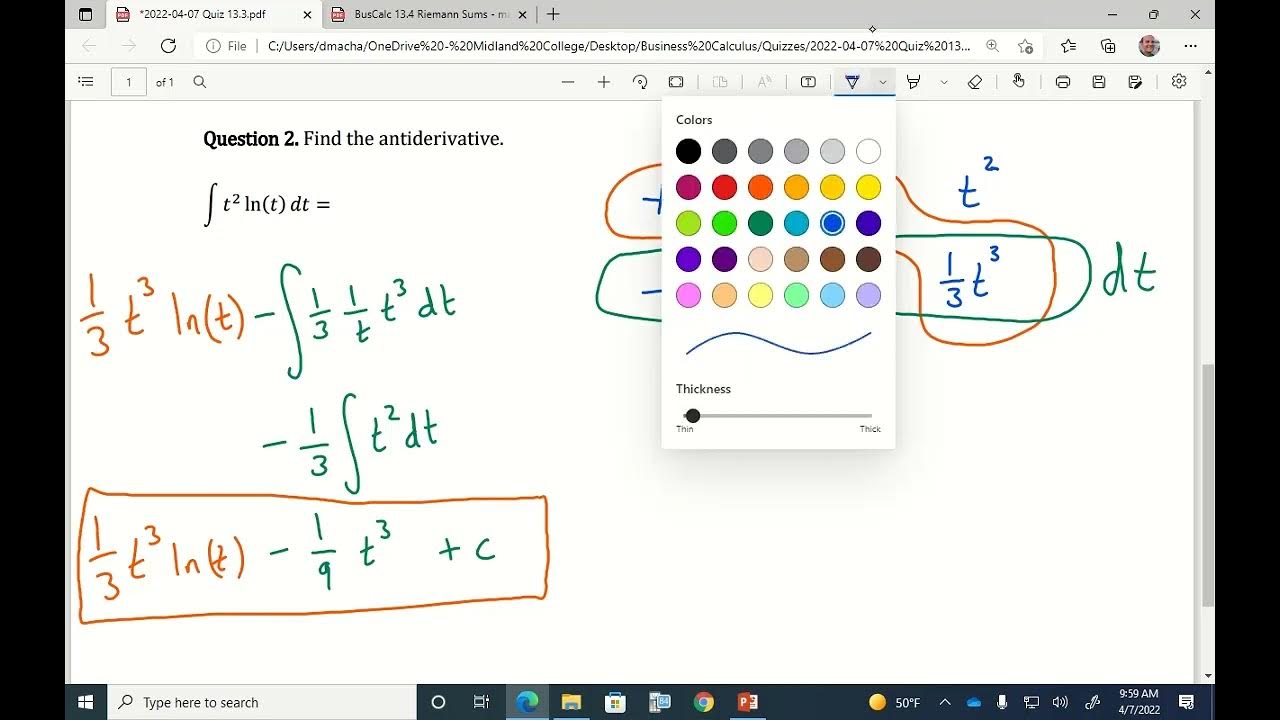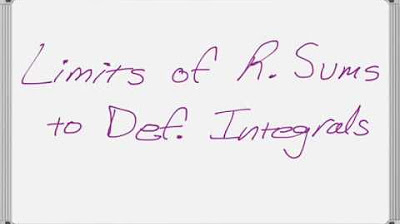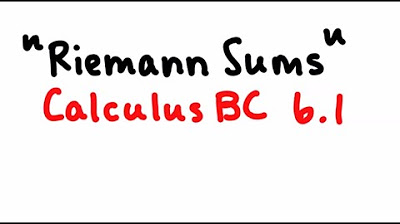"Reverse" Riemann Sums | Finding the Definite Integral Given a Sum
TLDRThe video script delves into Riemann integration, focusing on the application of Riemann sums to solve specific problems. It begins by defining the integral of a function over an interval using Riemann sums and emphasizes the importance of understanding the geometric interpretation of this concept. The script then guides viewers through the process of converting a Riemann sum into a definite integral, illustrating this with two examples. The first example is straightforward, involving the tangent function, while the second is more complex, requiring the unraveling of a 'messy' summation to identify the function it represents. Throughout, the script highlights the need to understand how to compute the 'excise' (likely a typo for 'exact') and 'Delta X's,' which are crucial for the Riemann sum method. The video aims to equip viewers with the skills to apply Riemann integration to various problems, fostering a deeper understanding of the subject.
Takeaways
- 📚 The Riemann integral is defined by the limit of a sum of the function values at specific points (X_i) multiplied by the width of the interval (ΔX).
- 🔢 ΔX is calculated as the difference between the upper and lower limits of the interval (B - A) divided by the number of subintervals (N).
- 📈 X_i, the points at which the function is evaluated, is given by the starting point (A) plus the index (i) times ΔX.
- 🏞️ The process involves a geometric interpretation where the function values represent the height of rectangles in the Riemann sum.
- 🔁 The transition from Riemann sum to definite integral involves replacing ΔX with the differential 'dX' and X_i with the variable 'X'.
- 🧮 When the interval and function are given, you write down the sum. Conversely, given the sum, you aim to find the function it approximates.
- 🔄 For right endpoint approximations, the function value at each subinterval's right endpoint is used in the sum.
- 📐 The formula for X_i can be rearranged to solve for 'i' in terms of X_i, which is useful when the summation expression is complex.
- 🧵 The integral's limits are determined by the interval provided in the problem statement, which in the example is from 0 to 3.
- ➗ The integral's 'dX' term originates from the ΔX term in the Riemann sum, symbolizing the infinitesimally small width of each subinterval as N approaches infinity.
- 📉 The tangent function in the example represents the integrand, and as the sum turns into an integral, the constant terms (like 2) are incorporated into the function of X.
- 🔍 In more complicated examples, you may need to identify and isolate the ΔX and X_i terms within a complex summation expression before converting it to an integral.
Q & A
What is the definition of the Riemann integral using Riemann sums?
-The Riemann integral of a function from 'a' to 'B' is defined as the limit of the sum of the function evaluated at points 'Xi' multiplied by 'Delta X', as the number of subdivisions 'n' approaches infinity.
How is the 'Delta X' calculated in the context of Riemann sums?
-Delta X is calculated as the difference between the upper limit 'B' and lower limit 'a' divided by the number of subdivisions 'N', which is expressed as (B - a) / N.
What is the formula for calculating 'Xi' in a Riemann sum?
-Xi is calculated as the starting point 'a' plus the index 'i' times Delta X, which can also be expressed as a + (i * (B - a)) / N.
What is the geometric interpretation of the Riemann sum?
-The Riemann sum is a way to approximate the area under a curve by dividing the region into rectangles and summing their areas. As the number of rectangles increases, the approximation becomes more accurate.
What is the reverse problem in the context of Riemann sums?
-The reverse problem involves starting with a given Riemann sum and interval 'a' to 'B', and determining the function that the sum is approximating.
How do you convert a Riemann sum to a definite integral?
-To convert a Riemann sum to a definite integral, you replace the summation index 'i' with the variable 'X', 'Xi' with 'X', and 'Delta X' with 'dX' or 'DX', and integrate over the given interval.
What is the interval specified in the video for the Riemann sum example?
-The interval specified in the video for the Riemann sum example is from 0 to 3.
How does the 'Xi' term transform when converting a Riemann sum to a definite integral?
-The 'Xi' term transforms into the variable 'X' when converting a Riemann sum to a definite integral.
In the video, what is the function evaluated at the 'Xi' points in the Riemann sum?
-In the video, the function evaluated at the 'Xi' points is the tangent of (2 + 3i) times 3/N.
What is the role of 'n' in the Riemann sum formula?
-In the Riemann sum formula, 'n' represents the number of subdivisions or intervals used to approximate the integral. As 'n' increases, the approximation becomes more precise.
How does the video script illustrate the process of finding the definite integral from a given Riemann sum?
-The video script illustrates the process by first identifying the interval and the function within the sum, then substituting the 'Xi' with 'X', 'Delta X' with 'DX', and finally integrating over the specified interval.
What is the significance of using right endpoint approximations in the Riemann sum?
-Using right endpoint approximations in the Riemann sum means that the function is evaluated at the upper limit of each subinterval to approximate the area under the curve, which is a common method for simplifying the calculation of integrals.
Outlines
📚 Introduction to Riemann Integration
This paragraph introduces the concept of Riemann integration and its application to specific problems. The speaker explains the definition of an integral using Riemann sums and emphasizes the importance of understanding how to compute the exact value and the Delta X's. The process involves identifying the function from a given sum (the reverse problem) or vice versa. The speaker also discusses the formulas for Delta X and X sub I, which are crucial for right endpoint approximations. The example provided involves calculating the integral from 0 to 3 of the function tangent of (2 + 3i/N) times 3/N, using right endpoints.
🔍 Transforming Riemann Sums to Definite Integrals
The second paragraph delves into the process of converting a Riemann sum into a definite integral. The speaker outlines the steps to identify the infinitesimal version of Delta X, which becomes DX, and the transformation of X sub I into the variable X within the integral. The example given involves a more complex summation, where the speaker works through unraveling the expression to identify the components that will transform into the function and the differential element. The focus is on recognizing patterns within the summation that correspond to the function and the interval, and then substituting these into the integral form. The end result is a definite integral that represents the limit of the sum over the interval from 0 to 3.
🧮 Definite Integral from Riemann Approximation
The final paragraph summarizes the process of finding the definite integral corresponding to a given Riemann approximation on the interval from 0 to 3. The speaker reiterates the importance of identifying the components of the summation that will transform into the function and the differential element in the integral. The paragraph concludes with the speaker expressing satisfaction with the progress made in transforming the messy expression into a clear definite integral, which is a significant step in understanding Riemann integration.
Mindmap
Keywords
💡Riemann Integration
💡Riemann Sums
💡Interval
💡Delta X (ΔX)
💡X_i
💡Definite Integral
💡Right Endpoint Approximation
💡Limit
💡Summation
💡Function
💡Tangent
Highlights
Introduction to a particular type of problem involving Riemann integration.
Definition of the interval via Riemann sums and its importance in understanding the integral.
Explanation of the geometric derivation of Riemann sums from previous videos.
Application of Riemann sums in specific problems, including reverse problems.
Formulas for computing the exact value and the Delta X's in Riemann sums.
Use of right endpoint approximations in Riemann sums.
Example calculation of a Riemann sum with the function tan(2 + 3i) * (3/N).
Identifying the interval for the integral as [0, 3] based on the given problem.
Transformation of the Riemann sum into a definite integral by replacing ΔX with dx and Xi with x.
Writing the definite integral for the given Riemann sum involving the tangent function.
Second example with a more complicated summation, maintaining the interval [0, 3].
Unraveling the summation to identify ΔX and Xi, even in a complex expression.
Substitution of expressions to transform the summation into a function of x.
Identification of the integral's interval, transformation of ΔX to dx, and Xi to x.
Final expression of the definite integral corresponding to the Riemann approximation on the interval [0, 3].
Emphasis on the process of transforming summation components into integral components.
Explanation of how to handle the transition from summation to integration in Riemann sums.
Transcripts
Browse More Related Video
5.0 / 5 (0 votes)
Thanks for rating:





